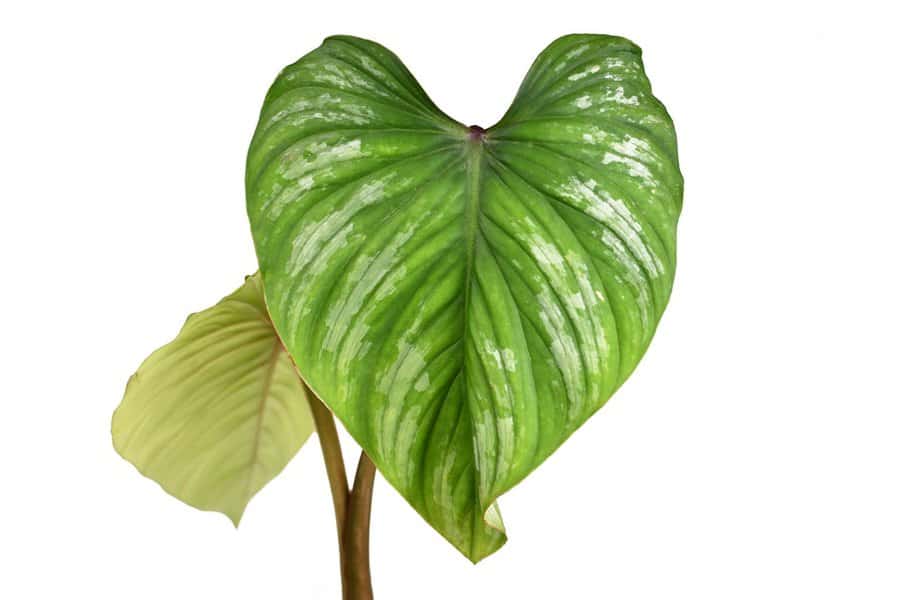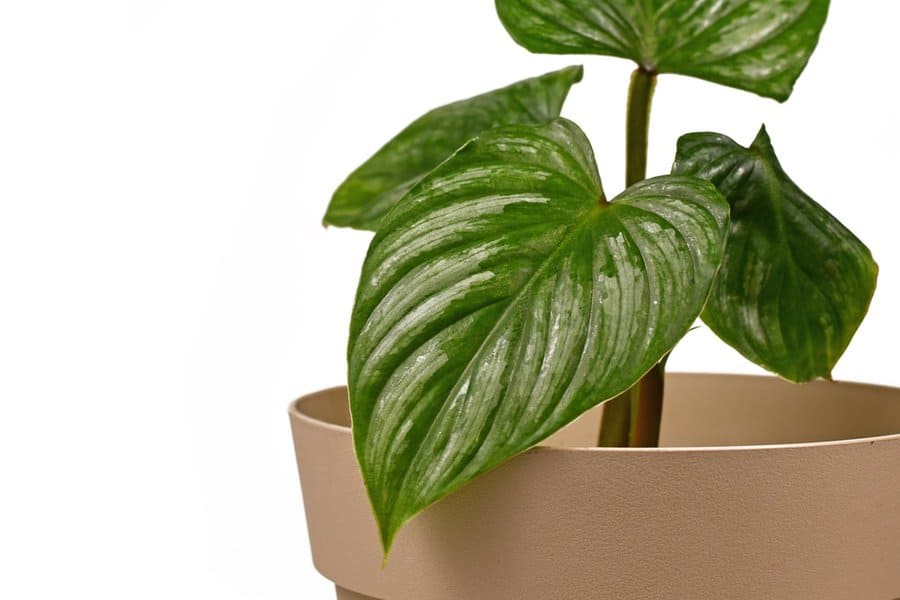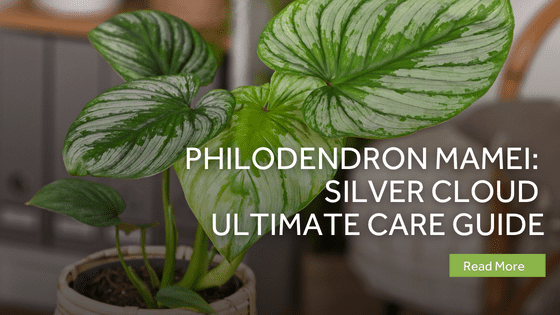The Philodendron mamei is an attractive plant perfect for beginners and experienced plant lovers alike. It works well in warmer regions and loves humidity but can be grown indoors in the right environment.
It doesn’t need much care, but it can be toxic, so use caution around children or pets.
Table of Contents
Philodendron Mamei Overview

The Philodendron mamei, known as the Silver Cloud, thanks to its leaves with silver dust that mimics clouds, this plant grows great indoors or outdoors as ground cover.
The Philodendron Mamei is part of the Araceae family and the Philodendron genus. The Philodendron genus comprises more than 500 climber and nonclimber perennials. The plant originates in Ecuadorian rainforests and is known for clearing the air of harmful toxins, including formaldehyde. It can be a great addition inside your home to clear the air or add an elegant touch. Outdoors, it makes a beautiful ground cover.
Other varieties of the Philodendron plants include:
Philodendron sodiroi – Unlike the mamei plant, the sodiroi plant is a climber. These plants grow tall while the mamei plants grow wide. However, both the Philodendron mamei and sodiroi have silvery leaves.
Philodendron plowmanii – The Philodendron plowmanii plants don’t have the same silvery texture as the mamei plants. The leaves on the plowmanii are much thicker, but like the mamei plant, it’s also a creeper.
| Botanical Name | Philodendron Mamei |
| Family | Araceae |
| Genus | Philodendron |
| Origin | Ecuador |
| Sunlight | Filtered sunlight |
| Watering | Once per week or as needed |
| Soil | Well draining soil |
| Temperature | 65 – 80 degrees |
| Propagation | Stem cuttings |
| Re-Potting | Usually, after 12 months |
| Pests and Diseases | Spider mites, aphids, moths, mealy bugs, fungus gnats |
| Toxicity | Toxic to humans and animals |
Philodendron Mamei Features
The Philodendron Mamei has large, heart-shaped leaves with stems that can grow up to 4 feet, resembling stalks. The plant’s nodes grow close together, so the foliage looks much thicker than many other plants. If you want a full plant, keep up with the plant’s fertilizing needs, as pruning the Philodendron mamei is not recommended.
The leaves can get quite large depending on where it’s grown. The leaves mature to 5 to 8 inches if you keep the plant indoors. However, outdoors, the leaves can grow as large as 18 inches and spread across the ground.
The plant flowers very infrequently because it’s an Aroid of the Araceae family. Aroids are part of the monocotyledonous family. In this family, there are male, female, and sterile flowers. When the female flowers mature, they accept the male’s pollen and reproduce. This can take 15+ years, so don’t expect flowers very often.
The Philodendron mamei is a naturally creeping aroid. This means it grows well on a sphagnum moss totem pole indoors to make it climb or on the ground as a ground cover outdoors. If you grow it on a pole, the leaves remain a manageable size and extends 3 feet tall. However, if grown outdoors, the leaves can get quite large and extend up to 15 feet long, but there’s no need to prune them unless you find decayed or dead leaves.
Unfortunately, the Philodendron species is toxic to humans and pets because of its level of calcium oxalate crystals. If consumed, animals can experience digestive issues, and humans can experience hives on the body and ulcers in the mouth from the calcium oxalate crystals. Therefore, keeping these plants away from children and animals is essential. While it’s not deadly, it still threatens animals and humans.
Philodendron Mamei Care Guide
Fortunately, caring for Philodendron Mamei is extremely easy, which is why it’s an excellent option for beginners.
Ideal Growing Place
The Philodendron Mamei grows well indoors or out. Its growing season is spring and summer; as long as it has adequate indirect sunlight, it will thrive. Indoors, placing it near an east or west-side facing window gives it the best chance of surviving. However, it doesn’t like direct sunlight and will let you know quickly if you make that mistake.
The plant has been known to thrive well in low light conditions as it originated along the shadowy banks in Ecuador. This makes it a great option for those underlit indoor corners you don’t know what to do with in your home.
Outdoors it grows best in USDA zones 9b to 11. However, it’s prone to sunburn, so slowly acclimate it to its new area outdoors and watch the plant’s health. It grows best under a large, shady tree or any other cover that allows some sunlight but not too much.
Water
Watering frequency is essential for the health of your Philodendron mamei. Watering the plant weekly is usually enough. If you overwater it, it’s susceptible to root rot, which can cause premature death.
A good practice is to water the plant when the upper layer of soil is approximately 70% dry. Make sure the pot can drain water easily to avoid root rot. Without proper drainage, the plant will not survive.
Sunlight
When considering the Philodendron mamei care, filtered sunlight is best, but they also do well in low light conditions. Unfortunately, they don’t do well in direct sunlight, so you must use caution when planting them outdoors.
You can tell by the leave’s colors what it needs. If it has bright green leaves, the plant needs more sunlight. But, if the leaves look very silvery, they may have too much light exposure. The silvery variegation is created to protect the leaves from too much sun.
Try moving the plant to an area with indirect sunlight and see if the leaves look healthier.
Temperature
The Philodendron mamei plants do not like cold temperatures. They do best in temperatures of 65 to 80 degrees Fahrenheit. If you grow the plants outdoors, as the cold temperatures decrease below 55, it’s crucial to bring the plant indoors. You must keep the plant away from frost as they will not survive — tropical plants like this one, like warmer climates.
Soil
The Philodendron mamei plant needs well-draining soil. If you’re planting it indoors or in a pot, use loose potting soil made of organic matter. If you use traditional potting soil, include peat moss, orchid bark, or perlite to enhance drainage. It’s best to avoid wet and soggy soil.
Including large clumps of coconut husk or cocoa bark in the pot can also help maintain the plant’s health. The large chunks give the roots a surface to climb on and get more moisture.
You May Also Like: How To Prepare Garden Soil For Next Season
Humidity
Part of the Philodendron mamei care is proper humidity levels. The plant prefers 60 percent humidity because of its tropical roots. If your home doesn’t have enough humidity in the winter months, adding a humidifier to your home should provide adequate levels.
However, this is one of the highly tolerant tropical plants, so don’t stress yourself out worrying about the humidity levels. Instead, focus on the watering frequency and sunlight exposure.
If the plant is outdoors, it should thrive in the proper zones, and you shouldn’t worry about the humidity levels.
Fertilizer
The large leaves on the Philodendron mamei require plenty of fertilizer. In the spring and summer months, its growing season, fertilize monthly. You can purchase a commercial fertilizer or create your own with organic matter such as bark and decomposed leaves.
During the winter months, it’s unnecessary to fertilize the plant. You can cause it more harm than good fertilizing in the non-growing seasons.
It’s important not to fertilize the plant but to give it enough nutrients that it’s able to grow during the growing season.
Pinching/Pruning
Pruning isn’t a significant necessity this plant has because it’s a self-heading philodendron. This means pruning isn’t necessary. However, if the leaves look ill or damaged, you can carefully prune them to avoid harming the rest of the plant.
Don’t prune the plant to make it grow or look fuller, though. This isn’t how the plant is meant to grow. Pruning is only if there are leaves that aren’t healthy.
Potting and Repotting
The Philodendron mamei plants need a lot of space. Usually, starting with a 10-inch in diameter pot is best, but make sure it has plenty of drainage holes. Also, because they are creepers, they need sphagnum moss poles to grow up instead of out.
Usually, these plants last in their initial pot for about one year. If you notice it outgrowing the pot sooner, repot it immediately. When you repot, move it to a pot three inches larger than the current pot to give the leaves plenty of room to grow.
If the plant is too large or you want the leaves to grow even larger, you can move the plant outdoors. Just keep it out of the direct sunlight as it will cause damage or premature death.
Growth Zone
The Philodendron mamei grows best in USDA zones 9b to 11. In these zones, the plant can remain outdoors year-round. If you’re in any other zone, it makes a good patio plant that you can bring indoors as soon as the temperature drops. Keep careful track of the temperature and bring the plant in when it hits 65 degrees or lower.
Common Pests, Toxins, Diseases & Other Problems
In perfect conditions, the Philodendron mamei is disease and pest-resistant. However, it has its share of issues, including spider mites, aphids, moths, mealybugs, scale, and thrips.
Keep an eye on the plant for brown or yellow dots, spider webs, withering leaves, or root rot. If you notice the plant doesn’t look healthy, try neem oil or insecticidal soap to clean the leaves gently. If you wash the leaf surface, gently but thoroughly dry them to avoid mold and mildew growth.
Propagation
Philodendron mamei propagation is just as easy as caring for the plant. It makes a great and easy gift, or you can grow more plants for your own enjoyment.
To propagate Philodendron mamei plants, you’ll need a few cuttings. To cut the stems, use a sterile knife and make sure you take the stems from a healthy plant, keeping as many nodes as possible.
Remove any leaves on the stem’s lower end, but don’t touch the leaves at the top. Then, plant the stem cuttings in a small pot with well-draining soil. If you prefer to plant them directly into the larger pot they’ll live in, that’s okay too. When you plant the stems, ensure one node is at least three inches into the soil and that the soil is moist but not soaked.

Philodendron Mamei Mature Timeline
It takes three to four weeks for the roots to develop and mature. At this point, you can repot or plant them wherever you want.
Philodendron Mamei FAQ
How Much Does Philodendron Mamei Cost?
The average cost of a small Philodendron mamei plant is $50, and a larger plant can cost around $100.
Where Can I Find Philodendron Mamei for Sale?
The Philodendron mamei isn’t rare, but your best chance at finding it is on Etsy or other well-known plant nursery sites.
How Old Does Philodendron Mamei Have to Be Before They Bloom?
The Philodendron mamei must be at least one year old before it can bloom, but even in its natural habitat, it can take over a decade for it to bloom.
Is Mamei Philodendron a Fast Grower?
The Philodendron mamei is a fast grower and can reach as tall as 3 feet in full maturity. Regular pruning can keep it under control.
Is Philodendron Mamei a Crawler or Climber?
The Philodendron mamei is a crawler. In its natural habitat, it grows along the river banks. However, if you want it as a houseplant, you can train it to climb with proper support.
What Does Philodendron Mamei Smell Like?
The Philodendron mamei doesn’t have a smell usually; however, if it starts to smell foul, it could be a sign of a bacterial infection that requires immediate attention.
Does Philodendron Mamei Purify Air?
One of the popular reasons people buy the Philodendron mamei plant is to improve indoor air quality. It eliminates household toxins, making the air you breathe healthier without requiring an air purifier.
Is Philodendron Mamei a Hybrid?
The mamei plant isn’t a hybrid, but the Philodendron mamei aff is a hybrid. The most significant difference is the mamei aff has more silver coloring on its leaves.
Can You Grow Philodendron Mamei From Seeds?
You can grow Philodendron mamei plants from seeds or cuttings. If you grow from seeds, you simply plant the seeds in well-draining soil and wait for them to grow. However, this could take a very long time. The easier and faster way to propagate the mamei plant is to use fully grown cuttings from a mature plant.
How Do I Make Philodendron Mamei Look Fuller?
Pruning can damage the Philodendron mamei plant. Instead, to make it look fuller, you should keep up with its fertilizing needs. Fertilize the plant only during the growing season and use as much organic matter as possible to encourage more growth and create fuller leaves.
What’s the Difference Between Philodendron Sodiroi vs. Mamei?
The mamei plant is a creeper, growing close to the ground, spreading far and wide. The sodiroi, on the other hand, is a climbing plant. Its leaves also aren’t as silver as the mamei plant. Instead, they have a pink or reddish tint to them.
What’s the Difference Between Philodendron Mamei vs. Plowmanii?
The plowmanii plant has many similarities to the mamei plant, so much so that most people confuse them. For example, both plants have large, heart-shaped leaves and creep rather than climb. The mamei plant, however, grows much faster than the plowmanii, but the plowmanii plant is much more toxic and can possibly kill anyone that ingests it.
What’s the Difference Between Philodendron Mamei vs. Silver Cloud?
The Philodendron mamei and Silver Cloud plants are the same. Silver Cloud is the nickname for this plant because of its silvery leaves and cloud-like appearance.
What’s the Difference Between Philodendrom Mamei vs. Pastazanum?
The pastazanum plant ‘pasta plant’ has large, heart-shaped leaves like the mamei, but they are dark green versus silvery. The leaves are glossy, and the plant grows to as large as 5 feet tall and 4 – 6 feet wide.
Is Philodendron Silver Mamei a Succulent?
The Philodendron mamei isn’t a succulent. It is a tropical creeper plant from Ecuador.
How Long Do Philodendron Mamei Blooms Last?
The mamei flowers last during the growing season, which is the spring and summer months.
What Kind of Pot Is Suitable for the Mamei Plant?
To start, the mamei plant does well in a 10-inch diameter pot. It usually lasts in this size pot for a year, but if it grows fast and outgrows the pot, it can be repotted sooner.
Is the Philodendron Mamei Rare?
The Philodendron mamei is a rare plant, but you can find it on sites like Etsy and other online nurseries specializing in rare plants.
Is Philodendron Mamei Toxic to Pets and Humans?
Yes, the mamei plant is toxic to pets and humans. While it wouldn’t cause a fatality, it can cause allergic reactions and digestive issues in humans and pets.
Philodendron Mamei Silver Cloud: The Bottom Line
The Philodendron mamei is an easy-to-care plant that makes an excellent ground cover in the right conditions or as a climbing plant indoors. The plant can grow to 3 feet tall with proper TLC, and its ornate leaves are sure to be a conversation starter in your home.
Last Updated on August 31, 2022 by Gustaf Johansson




